Organic SLO_GEN table made with HI-MACS® amazes visitors at Gensler offices in Los Angeles
News Infurma02/09/2013
The SLO_Gen communal table is the new focal point of Gensler’s Los Angeles office lobby, and the result of an innovative partnership between Gensler and the Department of Architecture at the College of Architecture and Environmental Design at Cal Poly, San Luis Obispo (California). 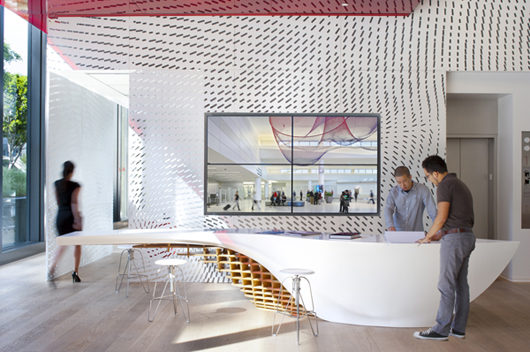 In order to achieve the stunning and outstanding curves, HI-MACS® turned out to be the key material thanks to its thermoforming properties, resistance, seamless joints and the smooth surface, which convinced the architects and engineers from the first meeting. In 2011, professors Jim Doerfler and Mark Cabrinha, co-directors of Cal Poly’s Digital Fabrication Lab (“d[Fab]Lab”) reached out to Gensler L.A. design director Shawn Gehle to create a fully-virtualized studio focused on digital fabrication and online collaboration tools.
In order to achieve the stunning and outstanding curves, HI-MACS® turned out to be the key material thanks to its thermoforming properties, resistance, seamless joints and the smooth surface, which convinced the architects and engineers from the first meeting. In 2011, professors Jim Doerfler and Mark Cabrinha, co-directors of Cal Poly’s Digital Fabrication Lab (“d[Fab]Lab”) reached out to Gensler L.A. design director Shawn Gehle to create a fully-virtualized studio focused on digital fabrication and online collaboration tools. 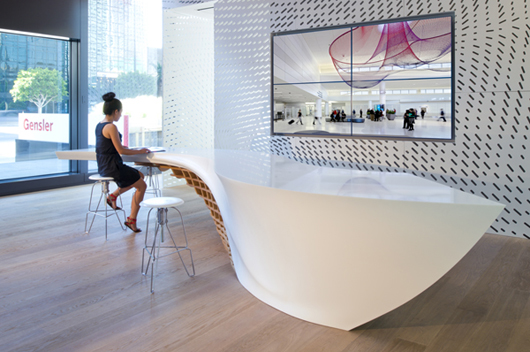 In response, Gehle authored a unique, 10-week seminar that would allow students access to the firm’s design talent and explore form-finding and digital fabrication techniques through the design of a custom furniture piece. The design brief simply outlined a piece that could accommodate standing and sitting space for guests and storage for the firm’s design publications. The piece would need to be site-specific and prominently featured in Gensler’s new downtown Los Angeles office.
In response, Gehle authored a unique, 10-week seminar that would allow students access to the firm’s design talent and explore form-finding and digital fabrication techniques through the design of a custom furniture piece. The design brief simply outlined a piece that could accommodate standing and sitting space for guests and storage for the firm’s design publications. The piece would need to be site-specific and prominently featured in Gensler’s new downtown Los Angeles office. 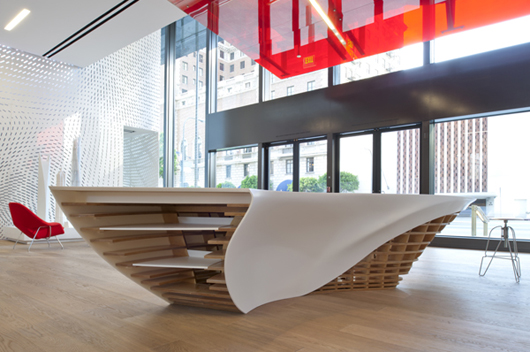 A virtual 3D prototype Beyond an initial in-person meeting, Cal Poly students and d[Fab]Lab faculty met with Gensler advisors via the online collaboration tool GoToMeeting to conduct weekly seminar discussions and review the team’s progress. In addition to bridging the 300-mile gap between designers in Los Angeles and students and faculty in San Luis Obispo, this method allowed professional consultants and materials specialists to participate easily, while exposing students to the kind of virtual collaboration that is prevalent in professional practice today. Maintaining a focus on a digital workflow, the team’s design and documentation process also was conducted virtually, substituting a 3-D model as the deliverable for fabrication in lieu of a traditional set of 2-D drawings. Over the course of the seminar, the original concepts of three students were developed and refined using the 3-D modeling software Rhino and T-Splines, and virtually reviewed and critiqued weekly with Gensler’s design staff. Structural engineers at Buro Happold and HI-MACS® solid surfacing material provider LG Hausys joined multiple discussions to examine schemes and offer insight on constructability, cost and structural integrity. A final, in-person meeting in Los Angeles focused on the review of physical prototypes and material samples, and enabled the team to address the challenges of forming fiberglass vs. Solid Surface HI-MACS® as the table’s predominant surface material.
A virtual 3D prototype Beyond an initial in-person meeting, Cal Poly students and d[Fab]Lab faculty met with Gensler advisors via the online collaboration tool GoToMeeting to conduct weekly seminar discussions and review the team’s progress. In addition to bridging the 300-mile gap between designers in Los Angeles and students and faculty in San Luis Obispo, this method allowed professional consultants and materials specialists to participate easily, while exposing students to the kind of virtual collaboration that is prevalent in professional practice today. Maintaining a focus on a digital workflow, the team’s design and documentation process also was conducted virtually, substituting a 3-D model as the deliverable for fabrication in lieu of a traditional set of 2-D drawings. Over the course of the seminar, the original concepts of three students were developed and refined using the 3-D modeling software Rhino and T-Splines, and virtually reviewed and critiqued weekly with Gensler’s design staff. Structural engineers at Buro Happold and HI-MACS® solid surfacing material provider LG Hausys joined multiple discussions to examine schemes and offer insight on constructability, cost and structural integrity. A final, in-person meeting in Los Angeles focused on the review of physical prototypes and material samples, and enabled the team to address the challenges of forming fiberglass vs. Solid Surface HI-MACS® as the table’s predominant surface material. 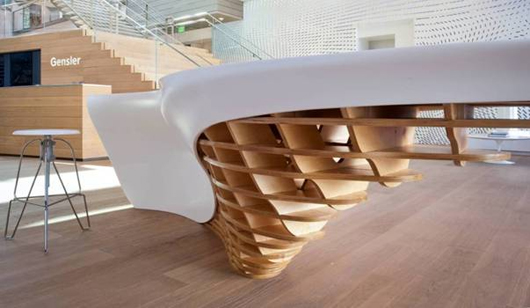
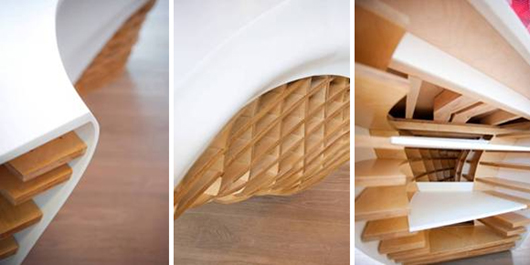 PROJECT INFORMATION Project: SLO_GEN table Location: Gensler Los Angeles, Los Angeles (California, USA) Design: Cal Poly, San Luis Obispo, Department of Architecture, College of Architecture and Environmental Design www.arch.calpoly.edu Faculty: Jim Doerfler, Mark Cabrinha Students: Ben Hait-Campbell, Cory Walker, Kegan Charles Flanderka Gensler Los Angeles www.gensler.com Engineering: Buro Happold: Garrett Jones, Gary Lau, Greg Otto, Liz Mahlow www.burohappold.com Fabrication: R.D. Wing Co., Inc. www.rdwing.com Material: HI-MACS® www.himacs.eu Photo credits: ©Gensler Los Angeles Source: HI-MACS® Read more news related HI-MACS® publisehd at Infurma Visit the HI-MACS® website
PROJECT INFORMATION Project: SLO_GEN table Location: Gensler Los Angeles, Los Angeles (California, USA) Design: Cal Poly, San Luis Obispo, Department of Architecture, College of Architecture and Environmental Design www.arch.calpoly.edu Faculty: Jim Doerfler, Mark Cabrinha Students: Ben Hait-Campbell, Cory Walker, Kegan Charles Flanderka Gensler Los Angeles www.gensler.com Engineering: Buro Happold: Garrett Jones, Gary Lau, Greg Otto, Liz Mahlow www.burohappold.com Fabrication: R.D. Wing Co., Inc. www.rdwing.com Material: HI-MACS® www.himacs.eu Photo credits: ©Gensler Los Angeles Source: HI-MACS® Read more news related HI-MACS® publisehd at Infurma Visit the HI-MACS® website
 In order to achieve the stunning and outstanding curves, HI-MACS® turned out to be the key material thanks to its thermoforming properties, resistance, seamless joints and the smooth surface, which convinced the architects and engineers from the first meeting. In 2011, professors Jim Doerfler and Mark Cabrinha, co-directors of Cal Poly’s Digital Fabrication Lab (“d[Fab]Lab”) reached out to Gensler L.A. design director Shawn Gehle to create a fully-virtualized studio focused on digital fabrication and online collaboration tools.
In order to achieve the stunning and outstanding curves, HI-MACS® turned out to be the key material thanks to its thermoforming properties, resistance, seamless joints and the smooth surface, which convinced the architects and engineers from the first meeting. In 2011, professors Jim Doerfler and Mark Cabrinha, co-directors of Cal Poly’s Digital Fabrication Lab (“d[Fab]Lab”) reached out to Gensler L.A. design director Shawn Gehle to create a fully-virtualized studio focused on digital fabrication and online collaboration tools.  In response, Gehle authored a unique, 10-week seminar that would allow students access to the firm’s design talent and explore form-finding and digital fabrication techniques through the design of a custom furniture piece. The design brief simply outlined a piece that could accommodate standing and sitting space for guests and storage for the firm’s design publications. The piece would need to be site-specific and prominently featured in Gensler’s new downtown Los Angeles office.
In response, Gehle authored a unique, 10-week seminar that would allow students access to the firm’s design talent and explore form-finding and digital fabrication techniques through the design of a custom furniture piece. The design brief simply outlined a piece that could accommodate standing and sitting space for guests and storage for the firm’s design publications. The piece would need to be site-specific and prominently featured in Gensler’s new downtown Los Angeles office.  A virtual 3D prototype Beyond an initial in-person meeting, Cal Poly students and d[Fab]Lab faculty met with Gensler advisors via the online collaboration tool GoToMeeting to conduct weekly seminar discussions and review the team’s progress. In addition to bridging the 300-mile gap between designers in Los Angeles and students and faculty in San Luis Obispo, this method allowed professional consultants and materials specialists to participate easily, while exposing students to the kind of virtual collaboration that is prevalent in professional practice today. Maintaining a focus on a digital workflow, the team’s design and documentation process also was conducted virtually, substituting a 3-D model as the deliverable for fabrication in lieu of a traditional set of 2-D drawings. Over the course of the seminar, the original concepts of three students were developed and refined using the 3-D modeling software Rhino and T-Splines, and virtually reviewed and critiqued weekly with Gensler’s design staff. Structural engineers at Buro Happold and HI-MACS® solid surfacing material provider LG Hausys joined multiple discussions to examine schemes and offer insight on constructability, cost and structural integrity. A final, in-person meeting in Los Angeles focused on the review of physical prototypes and material samples, and enabled the team to address the challenges of forming fiberglass vs. Solid Surface HI-MACS® as the table’s predominant surface material.
A virtual 3D prototype Beyond an initial in-person meeting, Cal Poly students and d[Fab]Lab faculty met with Gensler advisors via the online collaboration tool GoToMeeting to conduct weekly seminar discussions and review the team’s progress. In addition to bridging the 300-mile gap between designers in Los Angeles and students and faculty in San Luis Obispo, this method allowed professional consultants and materials specialists to participate easily, while exposing students to the kind of virtual collaboration that is prevalent in professional practice today. Maintaining a focus on a digital workflow, the team’s design and documentation process also was conducted virtually, substituting a 3-D model as the deliverable for fabrication in lieu of a traditional set of 2-D drawings. Over the course of the seminar, the original concepts of three students were developed and refined using the 3-D modeling software Rhino and T-Splines, and virtually reviewed and critiqued weekly with Gensler’s design staff. Structural engineers at Buro Happold and HI-MACS® solid surfacing material provider LG Hausys joined multiple discussions to examine schemes and offer insight on constructability, cost and structural integrity. A final, in-person meeting in Los Angeles focused on the review of physical prototypes and material samples, and enabled the team to address the challenges of forming fiberglass vs. Solid Surface HI-MACS® as the table’s predominant surface material. 
 PROJECT INFORMATION Project: SLO_GEN table Location: Gensler Los Angeles, Los Angeles (California, USA) Design: Cal Poly, San Luis Obispo, Department of Architecture, College of Architecture and Environmental Design www.arch.calpoly.edu Faculty: Jim Doerfler, Mark Cabrinha Students: Ben Hait-Campbell, Cory Walker, Kegan Charles Flanderka Gensler Los Angeles www.gensler.com Engineering: Buro Happold: Garrett Jones, Gary Lau, Greg Otto, Liz Mahlow www.burohappold.com Fabrication: R.D. Wing Co., Inc. www.rdwing.com Material: HI-MACS® www.himacs.eu Photo credits: ©Gensler Los Angeles Source: HI-MACS® Read more news related HI-MACS® publisehd at Infurma Visit the HI-MACS® website
PROJECT INFORMATION Project: SLO_GEN table Location: Gensler Los Angeles, Los Angeles (California, USA) Design: Cal Poly, San Luis Obispo, Department of Architecture, College of Architecture and Environmental Design www.arch.calpoly.edu Faculty: Jim Doerfler, Mark Cabrinha Students: Ben Hait-Campbell, Cory Walker, Kegan Charles Flanderka Gensler Los Angeles www.gensler.com Engineering: Buro Happold: Garrett Jones, Gary Lau, Greg Otto, Liz Mahlow www.burohappold.com Fabrication: R.D. Wing Co., Inc. www.rdwing.com Material: HI-MACS® www.himacs.eu Photo credits: ©Gensler Los Angeles Source: HI-MACS® Read more news related HI-MACS® publisehd at Infurma Visit the HI-MACS® websiteNews Infurma:
Online Magazine of the International Habitat Portal. Design, Contract, Interior Design, Furniture, Lighting and Decoration
